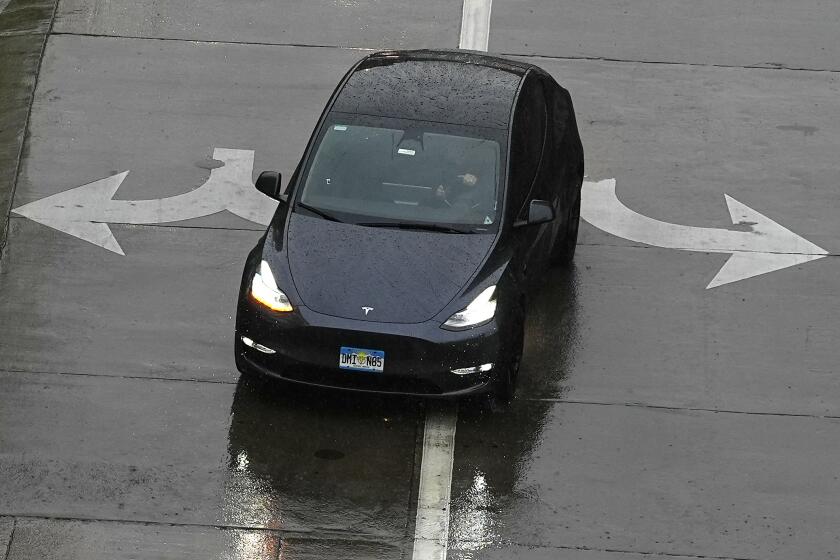Consumers Get an Earful From a New Medium
When Archie McDaniel walked into the Chief Auto Parts store in Gardena the other day, all he wanted was some STP oil treatment for his overheated car.
But while he walked down the store aisle, his body motion was quickly detected by an infrared device that suddenly blurted out a message--first in English and then in Spanish. The message asked him to purchase a bottle of Turtle Wax. He didn’t.
“I don’t care what the machine says,” said McDaniel, a Compton resident who is a production assistant for a Los Angeles film production company. “The best thing that they can do to sell Turtle Wax is to drop the price.”
But if some advertisers have their druthers, an array of so-called hidden voice product promotions--such as this one at Chief Auto Parts--may be the sound wave of the future. This same infrared device has been tested--with some success--at several supermarket chains.
At the same time, another manufacturer has also found a way to put a human voice onto a computer chip that will soon be placed inside mailed advertisements--and perhaps even be tucked into some magazine advertisements within the next year.
Suppose you opened up Time magazine, and out of nowhere, some silicon-chip-of-a-voice suddenly tried to sell you Scotch?
“My question is this,” said Greg Wood, president of the Los Angeles research firm Diagnostic Research. “At what point will the clutter be so bad that it will eventually sound like everybody is running around in an airport?”
Perhaps sooner than later. Although “talking” store shelf ads and talking magazine ads are still mostly in the testing stages, several advertisers and retailers have already shown keen interest in them.
“Most grocery shoppers aren’t sure what they want,” said Mort Gleberman, vice president of marketing at Canoga Park-based Ladd Electronics, which manufactures the Soundtron shelf talker. “But if you’re rolling past the Campbell soup, and just then a message tells you that Campbell soup is on sale, it could coax you to buy it.”
Well, maybe. But one advertising research specialist worries about overexposure. “What if you were grocery shopping and every can of something started shouting ‘Buy me,’ ” said Arnold Fishman, chairman of the Los Angeles marketing research firm, Lieberman Research West Inc. “It would drive shoppers crazy.”
But that was hardly the case earlier this year when a Boys grocery store test-marketed the shelf talker on nine different products. Shoppers who walked by these products--ranging from chili to pancake syrup--suddenly heard 16-second spoken advertisements. Eight of the nine products located by these talking ads showed substantial sales jumps.
Still, Boys isn’t sold on them. “Some customers objected to that kind of advertising,” said Rick Kester, vice president of merchandising at Boys Market Inc. And several customers at Chief Auto Parts told Calvin Jackson, the store’s assistant manager, that they were also frightened by the sudden voice ads. “One customer even told me that she thought it was God talking,” Jackson said.
Similar unexpected advertising chatter may soon spew out of your junk mail--and even in magazine ads.
Behind all this is a tiny, talking gadget called MailCall. And behind MailCall is a joint venture of Structural Graphics, an Essex, Conn.-based manufacturer, and Electronic Speech Systems Inc., of Emeryville, Calif. The device they make--a tiny computer chip encased in a one-inch “speaker”--can be placed inside brochures or advertisements and “talk” several sentences.
The biggest problem is the high cost--up to $4 per unit. “It is very, very expensive,” said Richard McEvoy, senior vice president of marketing at Carillon Importers, which imports Absolut Vodka into the United States. For several years, Absolut has been regarded as an innovator in print advertising, and two years ago it produced a magazine print ad with a computer chip that played a Christmas carol. “I predict you’ll see talking ads in the next year or two, but not until these things are more cost-efficient.”
But the manufacturer says talking ads will be in consumer magazines within the next year. “This is just the beginning,” said Chris Crowell, president of Structural Graphics. “Of course, you can’t hit people every week with this kind of thing. The novelty would wear off.”
Some advertisers are even looking at reproducing celebrities’ voices on computer chips placed in print ads. “I’m also in the greeting card business,” said Crowell, “and I have about 30,000 Ronald Reagan greeting cards left over. If I can make the cards sound like him, they’d sell.”
Gallo May Soon Bring Account to L.A. Firm
Gallo may soon be calling Los Angeles its advertising home. Industry sources say that within the next few weeks, E. & J. Gallo Winery of Modesto is expected to officially name the Los Angeles ad agency Dailey & Associates as agency of record. Gallo has not officially named an agency since San Francisco-based Hal Riney & Partners resigned the account more than a year ago. Dailey would create ads for an estimated $40 million worth of the Modesto company’s wine business, including the Bartles & Jaymes Premium Wine Cooler brand. Gallo’s Champagne and brandy advertising, however, would likely be handled by agencies outside Los Angeles. Executives at Gallo and Dailey declined to comment.
Hold Off on Ad Blitz, Expert Advises Eastern
If former Baseball Commissioner Peter V. Ueberroth--and an investment group--end up owning Eastern Airlines, how should they advertise the newly won prize? One corporate identity consultant says Eastern should hold off on most advertising until it really has something to brag about--like improved service. “The first thing they have to do is get their employees to treat customers like human beings,” said Joel Portugal, consultant at the New York corporate identity consulting firm Anspach Grossman Portugal. “Then they have to get the planes to take off and land on time. Once they bring themselves out of the basement, then they’ll have something to advertise.”
Marketer Puts Self in L.A. Radio Spots
It is one thing to hear radio ads for Burger King, Budweiser or other consumer products. It might even coax you to buy a Whopper or a Bud. But what if you turned on your radio tomorrow and heard a commercial for a local marketing research firm? Would it coax you to go buy some research?
Well, Lieberman Research West Inc.--one of the West Coast’s largest marketing research firms--hopes so. About a month ago, the Los Angeles company, which has done marketing research for everyone from MGM/UA to McDonald’s, began running daily ads during the “Today in Advertising” segment broadcast each morning on classical music station KFAC 92.3 FM.
“To the best of our knowledge, a marketing research firm has never before advertised on the radio,” said Arnold Fishman, chairman of the company. More typically, research firms run print ads in trade journals. “For a research company,” said Fishman, “this is pretty aggressive stuff.”
Anti-Drug Messages Target Latino Audience
The anti-drug TV commercial opens with several shots of a Latino boy and his older brother at play. There’s a footrace, a stop at the local taco shop and even a basketball game. “I always wanted to be like my older brother,” the boy says in Spanish. “Then things started to change.”
Next, the ad shows scenes of the older brother buying drugs and stealing money. Finally, there is a shot of the older brother lying unconscious on the floor. “Drugs killed my brother,” says the younger brother. “I miss him.”
The ad, which was filmed in South Central Los Angeles, was created for the Media Advertising Partnership for a Drug Free America by the Newport Beach ad firm Mendoza, Dillon y Asociados. Although the Media Partnership’s anti-drug ads have received more than $225 million in donated media time and space nationwide, this ad is part of the organization’s first major effort to reach Latinos.
But the commercial, which recently began to air on Spanish-language television in the Los Angeles area, is also getting international recognition. “It’s now being aired in Mexico and South America,” said Andres Sullivan, senior vice president and creative director. “It went farther than we ever thought.”
Customers Tell the Story for Wendy’s
Nearly 400 consumers will do the talking in a new advertising campaign for Wendy’s Old Fashioned Hamburgers, which claims the ads make up one of the largest testimonial campaigns on television.
The campaign made its nationwide debut Monday and has been tailored to feature local residents in about 100 U.S. metropolitan areas. The campaign features Wendy’s founder R. David Thomas telling viewers that they can get their money back if they are not satisfied with the taste of their burger. More than 1,500 consumers were videotaped at random before Wendy’s selected the final 400 who would appear in the campaign.
In the Los Angeles area, viewers will see and hear a testimonial from Jeff Borsuk, 31, of Newport Beach. Borsuk said he was thirsty and hungry when the Wendy’s video crew approached him at a restaurant in Pomona. “I told them to take a hike until I finished my iced tea.”
The Los Angeles office of Grey Advertising has been chosen to handle $5-million in advertising for Mag Instrument Inc., one of the world’s largest makers of flashlights.



